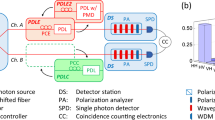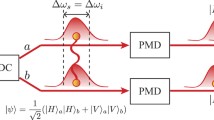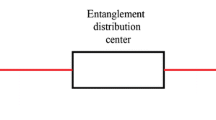Abstract
To build long-range quantum networks based on fiber channels, there is a growing demand for a generic method to describe the decoherence of polarization-entangled states in fiber environments. In this paper, we propose a theoretical model that describes the decoherence induced by the combined effects of polarization mode dispersion (PMD) and polarization-dependent loss (PDL). Consider a pair of polarization-entangled photons traveling along different optical paths and passing through PMD and PDL elements in arbitrary order. The density matrix and the concurrence of the output state are expressed in terms of parameters related to the orientation and magnitude of the PMD and PDL vectors. We obtain the upper bound on the remaining entanglement after EPR pairs have traversed the general fiber channels for a specific range of parameters. We show that it is possible to achieve nonlocal compensation of simultaneous PMD and PDL to force the output state restore original entanglement. By comparing the theoretical values of concurrence with the data from previous experiments, we prove the efficiency of the model basically.




Similar content being viewed by others
Data availability
All data generated or analysed during this study are included in this published article.
References
Altepeter, J.B., Hadley, P.G., Wendelken, S.M., Berglund, A.J., Kwiat, P.G.: Experimental investigation of a two-qubit decoherence-free subspace. Phys. Rev. Lett. 92(14), 147901 (2004)
Antonelli, C., Shtaif, M., Brodsky, M.: Sudden death of entanglement induced by polarization mode dispersion. Phys. Rev. Lett. 106(8), 080404 (2011)
Berglund, A.J.: Quantum coherence and control in one- and two-photon optical systems. Physics (2000)
Chen, L., Zhang, Z., Bao, X.: Combined PMD-PDL effects on BERs in simplified optical systems: an analytical approach. Opt. Express 15(5), 2106–2119 (2007)
Chen, J.P., Zhang, C., Liu, Y., et al.: Twin-field quantum key distribution over 511 km optical fiber linking two distant metropolitans. arXiv preprint arXiv:2102.00433 (2021)
Damask, J.N.: Polarization Optics in Telecommunications. Springer Science & Business Media, Berlin (2004)
Galtarossa, A., Menyuk, C.R.: Polarization Mode Dispersion. Springer, New York (2005)
Gisin, N., Huttner, B.: Combined effects of polarization mode dispersion and polarization dependent losses in optical fibers. Opt. Commun. 142(1–3), 119–125 (1997)
Gordon, J.P., Kogelnik, H.: PMD fundamentals: polarization mode dispersion in optical fibers. Proc. Natl. Acad. Sci. 97(9), 4541–4550 (2000)
Huttner, B., Geiser, C., Gisin, N.: Polarization-induced distortions in optical fiber networks with polarization-mode dispersion and polarization-dependent losses. IEEE J. Sel. Top. Quantum Electron. 6(2), 317–329 (2000)
Kirby, B.T., Jones, D.E., Brodsky, M.: Effect of polarization dependent loss on the quality of transmitted polarization entanglement. J. Light. Technol. 37(1), 95–102 (2018)
Mecozzi, A., Shtaif, M.: The statistics of polarization-dependent loss in optical communication systems. IEEE Photon. Technol. Lett. 14(3), 313–315 (2002)
Riccardi, G., Antonelli, C., Jones, D.E., Brodsky, M.: Simultaneous decoherence and mode filtering in quantum channels: theory and experiment. Phys. Rev. Appl. 15(1), 014060 (2021)
Ruan, L., Kirby, B.T., Brodsky, M., Win, M.Z.: Efficient entanglement distillation for quantum channels with polarization mode dispersion. Phys. Rev. A 103(3), 032425 (2021)
Shtaif, M., Rosenberg, O.: Polarization-dependent loss as a waveform-distorting mechanism and its effect on fiber-optic systems. J. Light. Technol. 23(2), 923–930 (2005)
Shtaif, M., Antonelli, C., Brodsky, M.: Nonlocal compensation of polarization mode dispersion in the transmission of polarization entangled photons. Opt. Express 19(3), 1728–1733 (2011)
Steinkamp, A., Vorbeck, S., Voges, E.I., et al.: Polarization mode dispersion and polarization dependent loss in optical fiber systems. Proc. SPIE Int. Soc. Opt. Eng. 241, 280–289 (2004)
Wootters, W.K.: Entanglement of formation of an arbitrary state of two qubits. Phys. Rev. Lett. 80(10), 2245–2248 (1998)
Yin, J., Cao, Y., Li, Y.H.: Satellite-based entanglement distribution over 1200 kilometers. Science 356, 1140–1144 (2017)
Yu, T., Eberly, J.H.: Evolution from entanglement to decoherence of bipartite mixed" X" states. arXiv preprint arXiv:quant-ph/0503089 (2005)
Acknowledgements
The author wishs to express their gratitude to EditSprings for the expert linguistic services provided.
Funding
This work was supported by National Key R&D Program of China [Grant Numbers No. 2017YFE0301303].
Author information
Authors and Affiliations
Contributions
YL finished theoretical calculations, figure plotting and manuscript writing by himself.
Corresponding author
Ethics declarations
Conflict of interest
The author has received research support from National Key R&D Program of China.
Ethical approval and consent to participate
Not applicable.
Consent for publication
Not applicable.
Additional information
Publisher's Note
Springer Nature remains neutral with regard to jurisdictional claims in published maps and institutional affiliations.
Appendix: Derivation of the density matrix in the configuration where the PDL element is preceding the PMD element
Appendix: Derivation of the density matrix in the configuration where the PDL element is preceding the PMD element
An alternative configuration to that discussed in the main text is that the fiber channel can be decomposed into a PDL element preceding a PMD element. The evolution of the waveform is illustrated in Fig.
5:
In this case, we need to introduce the coefficients \(a^{\prime}\), \(b^{\prime}\) to describe the relationship between the least- and most-attenuated states,\(\left| {u_{A} } \right\rangle\), \(\left| {u_{A}^{\prime } } \right\rangle\) and \(\left| {u_{B} } \right\rangle\), \(\left| {u_{B}^{\prime } } \right\rangle\), and the basis of the input states:
\(a\), \(b\) and \(a^{\prime}\), \(b^{\prime}\) are coefficients describing the relative orientation of the eigenstates and the basis of the input state. They satisfy the following relations:
After repeating the calculations of the main text, the density matrix elements of the output state in the basis
can be obtained as:
The normalization \(c^{\prime}\) constant is now given by
If \(\eta_{A}\) and \(\eta_{B}\) are set to 0, the density matrix in Eq. (32) describes the evolution under the influence of pure PMD effect, which is consistent with previous studies (Shtaif et al. 2011).
Rights and permissions
Springer Nature or its licensor (e.g. a society or other partner) holds exclusive rights to this article under a publishing agreement with the author(s) or other rightsholder(s); author self-archiving of the accepted manuscript version of this article is solely governed by the terms of such publishing agreement and applicable law.
About this article
Cite this article
Liu, Y. Disentanglement induced by combined effects of polarization mode dispersion and polarization-dependent loss in optical fibers. Opt Quant Electron 55, 720 (2023). https://doi.org/10.1007/s11082-023-05025-y
Received:
Accepted:
Published:
DOI: https://doi.org/10.1007/s11082-023-05025-y





